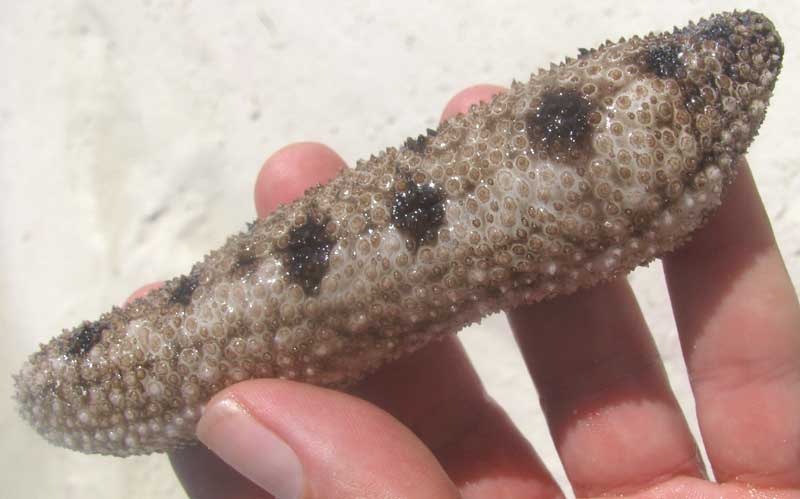Excerpts from Jim Conrad's
Naturalist Newsletter

from the June 19, 2011 Newsletter issued from Mayan Beach Garden Inn 20 kms north of Mahahual; Caribbean coastal beach and mangroves, ~N18.89°, ~W87.64°, Quintana Roo state, MÉXICO
LIKE A SAND-COVERED BANANA
Walking the beach during the lowest tide I've seen yet, on the sand a couple of feet from the water's edge I saw what looked like a sand-encrusted banana. A toe nudge indicated that it was firm, so I picked it up. It felt leathery and its surface was studded with thousands of low, conical, dullish spines. You can see what the thing looked like with the sand washed off above.
Not "banana," but "cucumber," I realized then. It was a sea cucumber. A lot of Googling later I couldn't be sure which species it was*...
*UPDATE: In 2024, with many more Internet resources for identification, this looks like what's called the Florida Sea Cucumber, HOLOTHURIA FLORIDANA.
This was my first sea cucumber, but only a couple of feet away lay my second one. Or at least the remains of one. One end of it was stuck into the sand, it was flat and mushy looking, and flies were buzzing it. These were the only two sea cucumbers I could find all up and down the beach, so what were two doing here together, with one of them dead and with one end in the sand?
I imagined a scenario in which the male guarded the egg-laying female, but as soon as I began reading about sea cucumber life history, that notion had to be abandoned. Most sea cucumber species simply release sperm and ova into ocean water, though a few species keep the eggs inside the female's body and "give birth" when the eggs hatch through the cucumber's ruptured body wall. Therefore, there's no nest building or laying of eggs belowground for sea cucumbers. It just remains a small mystery as to why two sea cucumbers in their respective conditions should have been found as they were.
Sea cucumber endoskeletons consist of tiny, calcified structures called ossicles joined by connective tissue. You can see a close-up of the cucumber's skin bumpy with subepidermal ossicles below:

Some sea-cucumber species move about on tube feet equipped with suckers, but on ours I couldn't find anything like feet. Sea cucumbers also display five-fold (pentaradial) symmetry, but that's visible only internally.
I wasn't sure whether our live sea cucumber was dangerously stranded by the unusually low tide, or whether it was doing something there important in its life cycle. I left it in a shallow pool of water. After a few minutes it began expelling jets of clear water from one end, though from the mouth or anus I don't know.
Our cucumbers were near large beds of Turtle Grass.